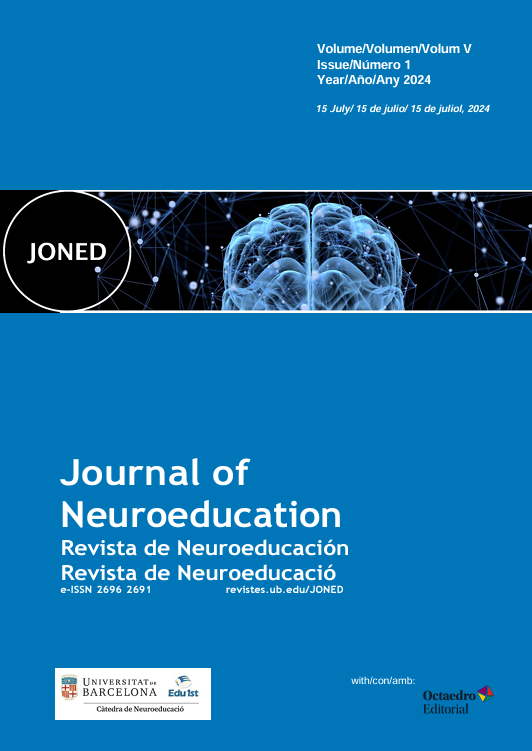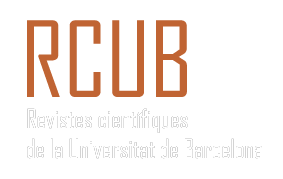Teaching – It’s a No Brainer, Right?: Using an Assessment Course to Bust Educators’ Neuromyths
DOI:
https://doi.org/10.1344/joned.v5i1.46856Paraules clau:
desinformació, neuromites, enquesta, avaluació, educacióResum
La desinformació sobre el cervell, coneguda com a neuromites, és prevalent entre els professionals de l’educació i sovint inadvertidament (mal) informa de les estratègies d’instrucció. En l’estudi actual, es va utilitzar un disseny de mètodes mixtos per provar com els recursos i la instrucció sobre neuromites lliurats com a part d’un curs d’avaluació van afectar les creences dels professors pre-servei d’educació primària (PST) sobre el cervell. En concret, aquest estudi té com a objectiu abordar: (1) On aprenen els PST els neuromites? (2) Es fa un enfocament explícit en el “neuromit-busting” en un canvi de curs necessari per a la comprensió de la ciència neuroeducativa? (3) Què entenen els PST de la ciència neuroeducativa i els impactes en la seva pràctica després d’aquest curs? Els resultats d’una pre-/post-survey mostren que moltes de les creences neuromites dels PST van canviar al final del curs. A través de respostes d’enquestes obertes, els PST van informar que havien après sobre neuromites a partir d’una varietat de recursos i que els seus pensaments sobre neuromites són polifacètics i complexos. Al final del curs, els PST relacionaven el que van aprendre sobre el cervell amb la importància de diferenciar la instrucció. Els resultats suggereixen que l’ús d’un enfocament de mètodes mixtos proporciona una visió ben completa de les creences dels PST sobre els neuromites. Incorporar informació sobre el cervell en els cursos d’educació pot ser una manera eficaç de promoure el pensament crític i dissipar els neuromites comuns entre els PST.
Referències
Grospietsch F, Mayer J. Professionalizing pre-service biology teachers’ misconceptions about learning and the brain through conceptual change. Educ Sci. 2018;8(3):120. doi: 10.3390/educsci8030120.
Grospietsch F, Mayer J. Pre-service science teachers’ neuroscience literacy: Neuromyths and a professional understanding of learning and memory. Front Hum Neurosci. 2019;13. doi: 10.3389/fnhum.2019.00020.
Howard-Jones P. Neuroscience and education: Myths and messages. Nat Rev Neurosci. 2014;15(12):817-824. doi: 10.1038/nrn3817.
Organisation for Economic Co-operation and Development [OECD]. Understanding the Brain: Towards a New Learning Science. OECD. 2002.
Pasquinelli E. Neuromyths: Why do they exist and persist? Mind Brain Educ. 2012;6(2):89-96. doi: 10.1111/j.1751-228x.2012.01141.x.
Torrijos-Muelas M, González-Víllora S, Bodoque-Osma AR. The persistence of Neuromyths in the educational settings: A Systematic review. Front Psychol. 2021;11. doi: 10.3389/fpsyg.2020.591923.
Dekker S, Lee N, Howard-Jones P, Jolles J. Neuromyths in education: Prevalence and predictors of misconceptions among teachers. Front Psychol. 2012. doi: 10.3389/fpsyg.2012.00429.
Macdonald KT, Germine L, Anderson A, Christodoulou JA, McGrath LM. Dispelling the myth: Training in education or neuroscience decreases but does not eliminate beliefs in neuromyths. Front Psychol. 2017;8. doi: 10.3389/fpsyg.2017.01314.
Simmonds A. How neuroscience is affecting education: Report of teacher and parent surveys. Wellcome Trust. [Online]. Available from: https://wellcome.org/sites/default/files/wtp055240.pdf.
Deligiannidi K, Howard-Jones P. The neuroscience literacy of teachers in Greece. Procedia Soc Behav Sci. 2015;174:3909-3915. doi: 10.1016/j.sbspro.2015.01.1133.
Zhang R, Jiang Y, Baobao D, Zhou A. Neuromyths in Chinese classrooms: Evidence from headmasters in an underdeveloped region of China. Front Educ. 2019;4. doi: 10.3389/feduc.2019.00008.
Dunn R. Learning style: State of the science. Theory Pract. 1984;23(1):10-19.
Dunn RS, Dunn K, Dunn KJ. Practical approaches to individualizing instruction: Contracts and other effective teaching strategies. Parker Publishing Company. 1972.
Geake J. Neuromythologies in education. Educ Res. 2008;50(2):123-133. doi: 10.1080/00131880802082518.
Kolb DA. Individual learning styles and the learning process. MIT.
Coffield F, Costa C, Müller W, Webber J. Beyond Bulimic Learning: Improving Teaching in Further Education. ERIC. 2014.
Willingham DT, Hughes EM, Dobolyi DG. The scientific status of learning styles theories. Teach Psychol. 2015;42(3):266-271. doi: 10.1177/0098628315589505.
Lilienfeld SO. 50 great myths of popular psychology: Shattering widespread misconceptions about human behavior. [Online]. Available from: https://ci.nii.ac.jp/ncid/BA91476696.
Pashler H, McDaniel MA, Rohrer D, Bjork RA. Learning styles. Psychol Sci Public Interest. 2008;9(3):105-119. doi: 10.1111/j.1539-6053.2009.01038.x.
Reiner C, Willingham D. The myth of learning styles. Change: The magazine of higher learning. 2010;45(5):32-35. doi:10.1080/000911383.2010.503139.
Kim M, Sankey D. Philosophy, neuroscience and pre-service teachers’ beliefs in neuromyths: A call for remedial action. Educ Philos Theory. 2017;50(13):1214-1227. doi: 10.1080/00131857.2017.1395736.
Lethaby C, Harries P. Learning styles and teacher training: Are we perpetuating neuromyths? ELT J. 2015;70(1):16-27. doi: 10.1093/elt/ccv051.
Ulusoy T, Bakir S, Zorluoglu SL. Neuromyths in Education. Eğitimde Kuram ve Uygulama. 2023;19(1):74-82. doi: 10.17244/eku.1256588.
McMahon K, Yeh CS, Etchells P. The impact of a modified initial teacher education on challenging trainees’ understanding of neuromyths. Mind Brain Educ. 2019;13(4):288-297. doi: 10.1111/mbe.12219.
Kuenzi JJ. Teacher preparation policies and issues in the Higher Education Act (No. R45407). Congressional Research Service. November 2018. Available from: https://crsreports.congress.gov.
Goswami U. Neuroscience and education: From research to practice? Nat Rev Neurosci. 2006;7(5):406-413. doi: 10.1038/nrn1907.
The Brainwaves Video Anthology. Daniel T. Willingham - Cognitive psychology in the classroom [Video]. YouTube. November 9, 2017. Available from: https://youtu.be/SpuD-rOebE0?si=4whuqUX5hZBafFQS.
Willingham D. Learning styles don’t exist [Video]. YouTube. August 21, 2008. Available from: https://youtu.be/sIv9rz2NTUk?si=siq2xvjnDN-pxjax.
Wiliam D. Embedded formative assessment (Strategies for classroom formative assessment that drives student engagement and Learning). 2nd ed. Solution Tree Press; 2017.
Oregon State University Center for Teaching & Learning. Neuromyths & learning fallacies cards [Card game]. Oregon State University Center for Teaching & Learning. [Online]. Available from: https://secure.touchnet.net/C20159_ustores/web/store_main.jsp?STOREID=126&SINGLESTORE=true.
Saldaña J. The coding manual for qualitative researchers. Sage; 2015.
Sheskin DJ. Handbook of parametric and nonparametric statistical procedures. 5th ed. Chapman & Hall/CRC Press; 2011.
McNemar Q. Note on the sampling error of the difference between correlated proportions or percentages. Psychometrika. 1947;12:153-157. doi: 10.1007/BF02295996.
Edwards AL. Note on the "correction of continuity" in testing the significance of the difference between correlated proportions. Psychometrika. 1948;13:185-187.
Blancheete Sarrasin J, Riopel M, Masson S. Neuromyths and their origin among teachers in Quebec. Mind, Brain, and Education. 2019 May;13(2):100-9.
Descàrregues
Publicades
Número
Secció
Llicència
Drets d'autor (c) 2024 Amanda Seccia, Karyn Allee

Aquesta obra està sota una llicència internacional Creative Commons Reconeixement-NoComercial 4.0.
Els autors que publiquen en aquesta revista accepten els següents termes:
a. Els autors conserven els drets d’autor i d’organisme a la revista el dret de la primera publicació
b. Els textos que es publicaran sota una Llicència d'Atribució No Comercial Creative Commons permeten altres activitats del treball, sempre que inclogui un reconeixement de l’autorització del treball, la seva actualització inicial en aquesta revista i els termes de la llicència, i no se'n faci un ús comercial.



